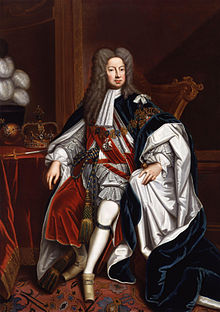
Back George I van Groot-Brittanje Afrikaans Georg I. (Großbritannien) ALS Georgius I Bretta Cyning ANG جورج الأول ملك بريطانيا العظمى Arabic جورج الاولانى ملك بريطانيا العظمى ARZ Xurde I de Gran Bretaña AST I Georq (Böyük Britaniya kralı) Azerbaijani بیرینجی جرج (بؤیوک بریتانیا) AZB Георг I (кароль брытанскі) Byelorussian Джордж I Bulgarian
| George I | |||||
|---|---|---|---|---|---|
 Portrait from studio of Godfrey Kneller, 1714 | |||||
| King of Great Britain and Ireland | |||||
| Reign | 1 August 1714 – 11 June 1727[a] | ||||
| Coronation | 20 October 1714 | ||||
| Predecessor | Anne | ||||
| Successor | George II | ||||
| Elector of Hanover | |||||
| Reign | 23 January 1698 – 11 June 1727[a] | ||||
| Predecessor | Ernest Augustus | ||||
| Successor | George II | ||||
| Born | 28 May / 7 June 1660 (O.S./N.S.)[a] Hanover, Brunswick-Lüneburg, Holy Roman Empire | ||||
| Died | 11/22 June 1727 (aged 67) (O.S./N.S.) Schloss Osnabrück, Osnabrück, Holy Roman Empire | ||||
| Burial | 4 August 1727 Leine Palace, Hanover; later Herrenhausen, Hanover | ||||
| Spouse | |||||
| Issue more... | |||||
| |||||
| House | Hanover | ||||
| Father | Ernest Augustus, Elector of Hanover | ||||
| Mother | Sophia of the Palatinate | ||||
| Religion | Protestant[1] | ||||
| Signature | |||||
George I (George Louis; German: Georg Ludwig; 28 May 1660 – 11 June 1727)[a] was King of Great Britain and Ireland from 1 August 1714 and ruler of the Electorate of Hanover within the Holy Roman Empire from 23 January 1698 until his death in 1727. He was the first British monarch of the House of Hanover.
Born in Hanover to Ernest Augustus and Sophia of Hanover, George inherited the titles and lands of the Duchy of Brunswick-Lüneburg from his father and uncles. In 1682, he married his cousin Sophia Dorothea of Celle, with whom he had two children; he also had three daughters with his mistress Melusine von der Schulenburg. George and Sophia Dorothea divorced in 1694. A succession of European wars expanded George's German domains during his lifetime; he was ratified as prince-elector of Hanover in 1708.
As the senior Protestant descendant of his great-grandfather James VI and I, George inherited the British throne following the deaths in 1714 of his mother, Sophia, and his second cousin Anne, Queen of Great Britain. Jacobites attempted, but failed, to depose George and replace him with James Francis Edward Stuart, Anne's Catholic half-brother. During George's reign the powers of the monarchy diminished, and Britain began a transition to the modern system of cabinet government led by a prime minister. Towards the end of his reign, actual political power was held by Robert Walpole, now recognised as Britain's first de facto prime minister.
George died of a stroke on a journey to his native Hanover, where he was buried. He is the most recent British monarch to be buried outside the United Kingdom.
Cite error: There are <ref group=lower-alpha> tags or {{efn}} templates on this page, but the references will not show without a {{reflist|group=lower-alpha}} template or {{notelist}} template (see the help page).
- ^ Brunner, Daniel L. (2006). "Anglican Perceptions of Lutheranism in Early Hanoverian England" (PDF). Lutheran Quarterly. XX: 63–82. Archived (PDF) from the original on 12 November 2020.
George was a Lutheran in Hanover, a Presbyterian in Scotland and an Anglican in England
- "The Hanoverians are here!". Historic Royal Palaces. 2022.
the monarch could only be Anglican
- "George I". Encyclopædia Britannica. 2022.
all British monarchs must be Protestants of the Church of England
- "Act of Settlement". The Royal Family. 2022.
The Sovereign now had to swear to maintain the Church of England (and after 1707, the Church of Scotland)
- "The Hanoverians are here!". Historic Royal Palaces. 2022.